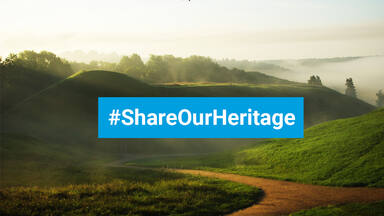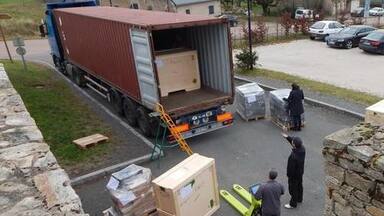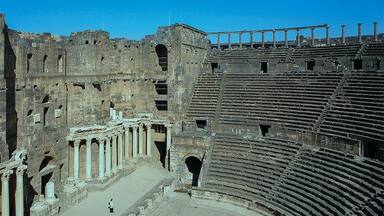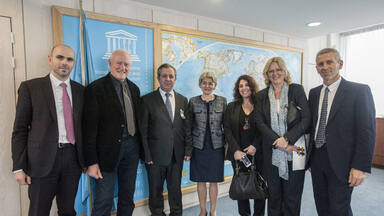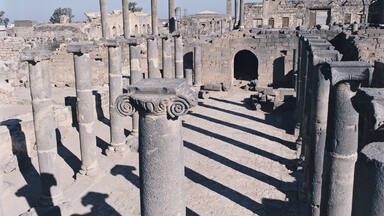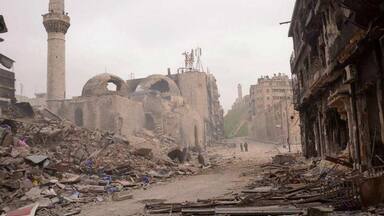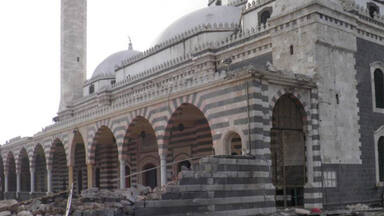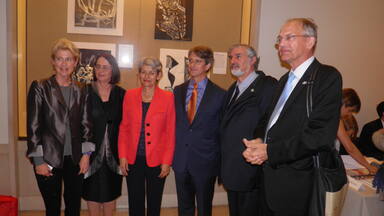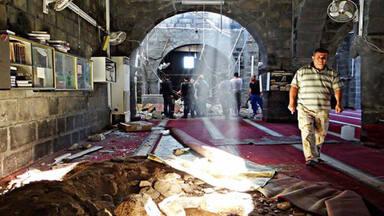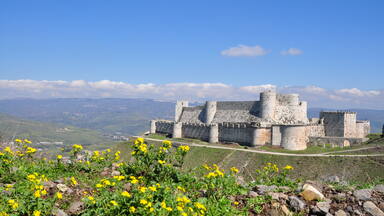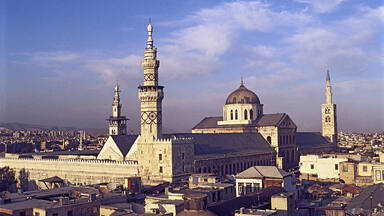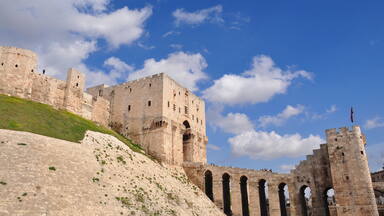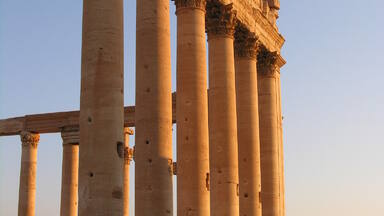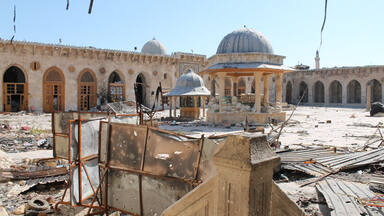Ancient City of Bosra
Ancient City of Bosra
Bosra, once the capital of the Roman province of Arabia, was an important stopover on the ancient caravan route to Mecca. A magnificent 2nd-century Roman theatre, early Christian ruins and several mosques are found within its great walls.
Description is available under license CC-BY-SA IGO 3.0
Ancienne ville de Bosra
Jadis capitale de la province romaine d'Arabie et importante étape sur l'ancienne route caravanière de La Mecque, Bosra conserve, enserrées dans ses épaisses murailles, un magnifique théâtre romain du IIe siècle, des ruines paléochrétiennes et plusieurs mosquées.
Description is available under license CC-BY-SA IGO 3.0
مدينة بصرى القديمة
شكّلت هذه المدينة قديماً عاصمة المقاطعة الرومانية العربية ومحطة هامة في طريق القوافل القديمة الى مكة. وقد حافظت داخل أسوارها السميكة على مدرّج روماني رائع يعود الى القرن الثاني، ناهيك عن آثار من المسيحية الأولى وعدد من المساجد.
source: UNESCO/CPE
Description is available under license CC-BY-SA IGO 3.0
布斯拉古城
布斯拉古城曾是古罗马阿拉伯省的首府,是通往麦加的沙漠商队路线上一个重要的中途站。在布斯拉城墙中保存着一座公元2世纪的富丽堂皇的古罗马剧场、早期基督教的遗迹和几座清真寺。
source: UNESCO/CPE
Description is available under license CC-BY-SA IGO 3.0
Старый город в Босре
Босра, бывшая одно время столицей древнеримской провинции Аравия, служила важным местом остановок караванов на древнем пути в Мекку. Внутри кольца его протяженных стен обнаружены великолепный древнеримский театр II в., руины раннехристианских памятников и несколько мечетей.
source: UNESCO/CPE
Description is available under license CC-BY-SA IGO 3.0
Ciudad vieja de Bosra
Antigua capital de la provincia romana de Arabia e importante etapa de la ruta de las caravanas que conducía a La Meca, Bosra conserva en el recinto de sus sólidas murallas un magnífico teatro romano del siglo II, vestigios arqueológicos paleocristianos y varias mezquitas.
source: UNESCO/CPE
Description is available under license CC-BY-SA IGO 3.0
古代都市ボスラ
source: NFUAJ
Oude stad van Bosra
Bosra was een belangrijke tussenstop op de oude pelgrims- en handelsroute naar Mekka. Het was ooit de hoofdstad van de Romeinse provincie Arabië. Binnen de grote muren van de oude stad zijn een prachtig 2e-eeuws Romeins theater, vroegchristelijke ruïnes en verschillende moskeeën te vinden. Het theater – waarschijnlijk gebouwd onder de heerschappij van Trajanus – is het enige monument van dit type, met de bovenste galerij in de vorm van een overdekte zuilengang die volledig bewaard is gebleven. Bosra telde vroeger 80.000 inwoners, vandaag de dag is het nog slechts een dorp. Maar wel een van opvallende schoonheid.
Source: unesco.nl
Outstanding Universal Value
Brief synthesis
The name of Bosra occurs in the precious Tell el-Amarna tablets in Egypt, which date from the 14th century B.C. and represent royal correspondence between the Pharaohs and the Phoenician and Amorite kings. It became the northern capital of the Nabataean kingdom. In the year of 106 A.D, a new era began for Bosra when it was incorporated into the Roman Empire.
Alexander Severus gave it the title Colonian Bostra and Philip the Arab minted currency especially for it. During Byzantine times, Bosra was a major frontier market where Arab caravans came to stock up and its bishops took part in the Council of Antioch. Bosra was the first Byzantine city which the Arabs entered in 634 in the phase of Islamic expansion.
Today, Bosra is a major archaeological site, containing ruins from Roman, Byzantine, and Muslim times. Further, Nabataean and Roman monuments, Christian churches, mosques and Madrasas are present within the city.
Its main feature is the second century Roman Theatre, constructed probably under Trajan, which has been integrally preserved. It was fortified between 481 and 1251 AD. Al-Omari Mosque is one of the oldest surviving mosques in Islamic history, and the Madrasah Mabrak al-Naqua is one of the oldest and most celebrated of Islam. The Cathedral of Bosra is also a building of considerable importance in the annals of early Christian architecture.
Bosra survived about 2500 years inhabited and almost intact. The Nabataeans, Romans, Byzantines and Umayyad, all left traces in the city, which is an open museum associated with significant episodes in the history of ideas and beliefs.
Criterion (i): The incorporation of the exceptionally intact 2nd century Roman theatre, complete with its upper gallery, into later fortifications to create a strong citadel guarding the road to Damascus represents a unique architectural achievement. The remains of the 6th century basilica of the martyrs Sergios, Bacchos and Leontios, the cathedral of Bosra, represent an extremely significant example of the centrally planned churches in terms of the evolution of early church architectural forms. The Mosque of Omar, restored in 1950, is one of the rare constructions of the 1st century of the Hegira preserved in Syria. The Madrasa Jâmi' Mabrak an-Nâqua is one of the oldest and most celebrated of Islam.
Criterion (iii): Of the city which once counted 80,000 inhabitants there remain today extensive ruins of Nabataean, Roman, Byzantine and Umayyad buildings. These ruins, including the major monuments mentioned under Criterion (i) above bear exceptional testimony to the past civilizations that created them.
Criterion (vi): In Islam, Bosra is associated with a significant episode in the life of the Prophet Mohammed, who is believed to have visited Bosra twice. At the end of his first visit, it is said that Monk Baheira indicated that Muhammad was to become a prophet.
Integrity (2009)
The Ancient city of Bosra is an inhabited archaeological site whose ruins had suffered greatly in the late 19th century. However, the large amount of surviving original fabric, including monuments of the Nabataean, Roman, Byzantine and Umayyad periods gives the site a high degree of integrity. The inhabitants of the village that has grown up amongst the ruins are being resettled outside the property. There is a need to define and manage a buffer zone to protect the setting.
Authenticity (2009)
The key surviving monuments of Bosra reflect the Outstanding Universal Value of the site. However, their setting is problematic in that a modern village had grown up among the ruins. A resettlement policy of the Directorate of Antiquities and Museums (DGAM) is allowing most families to move to new houses outside the precincts of the old town. Ultimately the old town will be abandoned again, to be turned into a dead city revitalized as an open air museum.
Protection and management requirements (2009)
The property is protected under the Antiquities Law 222 as amended in 1999. There is no management plan for the site and there are problems with conservation due to community issues, lack of funds and technical resources, and a lack of skilled labour. The Directorate of Antiquities and Museums is attempting to overcome these problems with the help of national and international institutions and foreign experts.
Recently the Syrian Government instigated a Master Plan project to recognize the importance of the site and to guide future use of Bosra city. A Protection Committee was established in 2007 to guide the project.
The DGAM is preparing terms of reference for implementing GIS system in the site; this project will start during 2009 and will continue for 1 year. There is a need to protect the setting of the property through an agreed and approved buffer zone.


